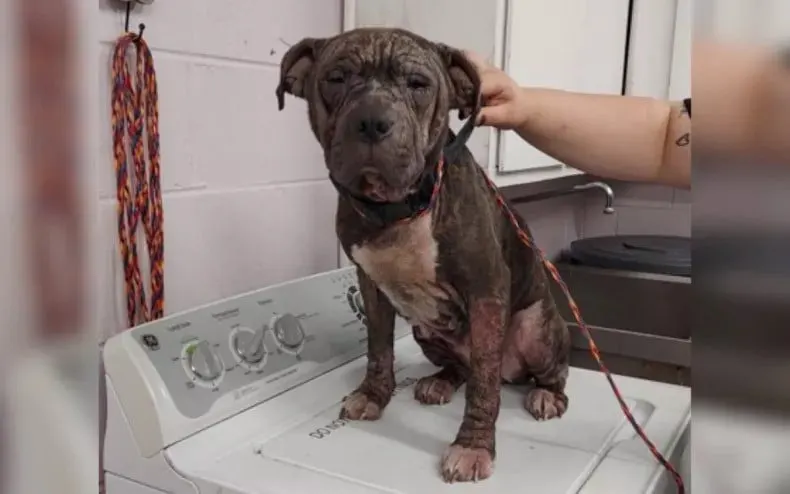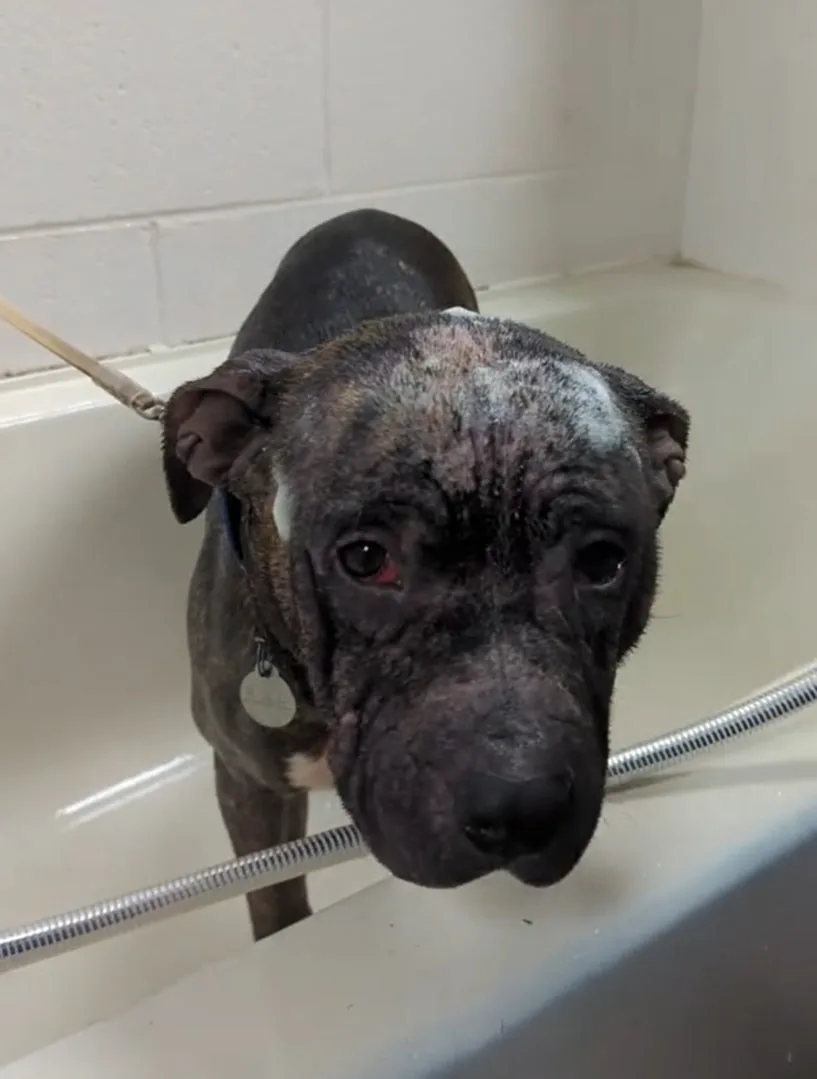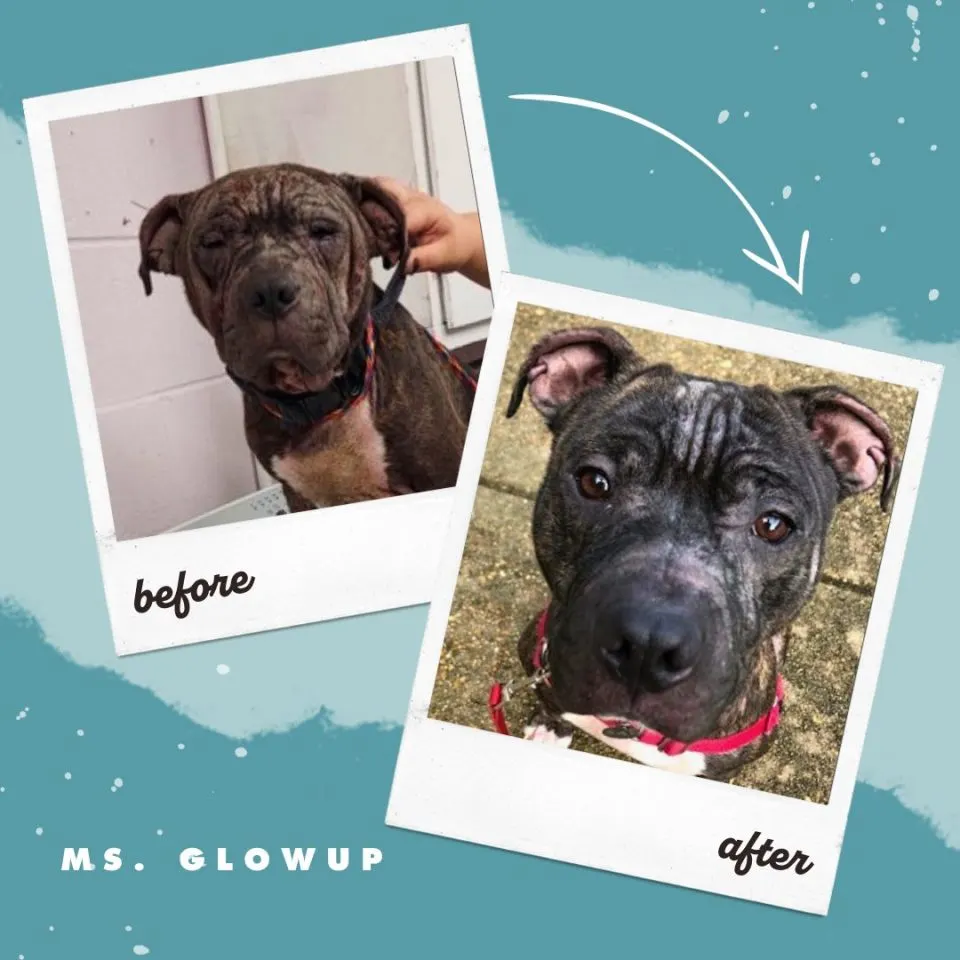So many dogs face distressing conditions at no fault of their own. Life on the street, mixed with cold temperatures, inadequate shelter, and lack of food take their toll, leaving these four-legged creatures in despair.
One such story comes from Virginia, where a dog was found in such horrible shape that the rescuers mistook her for another breed.
She hopelessly surrendered to the hoomans who immediately started the recovery process, and soon enough, the dog, later named Glowup, took everyone by surprise!
A Difficult Start In Life

Animal control in Petersburg, Virginia, picked up Glowup and immediately transferred her to Richmond Animal League, who accepted her in a heartbeat.
She was in extremely bad condition when she first arrived at the facility. Her skin was inflamed due to a severe case of demodectic mange, which is why the staff initially thought her breed was a Shar Pei.
“When this sweet girl arrived, her skin suffered from a nasty case of Demodex. She was missing hair, was covered in scabs, and her skin was thickened,” RAL wrote on Facebook.

Despite everything, her caregivers worked night and day to help this poor girl recover. She received meds and medicated baths on a regular basis, but what Glowup got the most from her saviors was lots of love.
Daily TLC, in combination with medical treatment, helped her come out of her shell and embark on a transformative journey. Everyone in the rescue soon fell in love with this amazing girl’s personality.
Within just weeks, Glowup was on her way to a full recovery. Her coat wounds started healing, and after a long time, she was finally on safe ground.
Mystery Resolved

Glowup’s recovery resolved another mystery – what breed she was!
Instead of the initial assumption that she was a Shar Pei due to her condition, the shelter staff finally learned her true identity. She was a pawdorable Pitbull mix with such a great personality.
In their Facebook post, the Richmond Animal League crew posted her ‘before and after photos,’ showing how much Glowup actually transformed during her recovery process.
“We began a course of treatment that included medicated baths to help her skin and the results speak for themselves. We think Ms. Glowup should be in ads for the shampoo; I mean, look at her amazing before and after photos,” the RAL team wrote.

She blossomed into a brand-new girl, happy to finally be surrounded by people who loved her. Even though her full past is vague, it is safe to say that Glowup will never have to deal with uncertainty again.
When the time comes, we’re pawsitive that this loving girl will be spending her days showering some family with love and affection. And, in return, she’ll get the coziest, most pawfect home!
If you’ve ever found yourself wondering why your furry friend is constantly whining, you’re not alone. Dog whining can be a puzzling behavior that many pet owners encounter. Understanding the reasons behind this vocalization can help you decipher what your pup is trying to communicate. From seeking attention to expressing discomfort, there are various factors that could be causing your dog to vocalize in this manner.
As a seasoned dog trainer, I’ve witnessed firsthand the different triggers that can lead to whining in dogs. It’s essential to pay attention to your dog’s body language and environment to get to the root of their whining behavior. By recognizing the potential causes behind their vocalizations, you can better address your dog’s needs and strengthen your bond with your four-legged companion.
Understanding Dog Whining: An Overview
The Language of Dogs
When it comes to understanding your dog’s whining, it’s essential to recognize that dogs communicate primarily through body language and vocalizations like barks, whines, and growls. Whining is a form of communication for dogs and can convey various emotions or needs. Paying attention to your dog’s vocal cues and accompanying body language can offer insights into what they are trying to tell you.
Identifying Different Whine Types
Dogs can whine for different reasons, and it’s crucial to identify the various types of whines to understand your pet better. Pain or discomfort: If your dog is whining persistently and you’ve ruled out the usual reasons like hunger or attention-seeking, they might be in pain or discomfort. Anxiety or stress: Whining can also be a sign of anxiety or stress in dogs, especially in new or unfamiliar situations. Attention-seeking: Dogs may whine to get your attention or as a way to communicate their needs, such as wanting to go outside or play. Medical issues: Sometimes, whining can be a symptom of an underlying medical problem, so it’s important to monitor your dog’s behavior and consult a veterinarian if needed. Understanding the different whine types can help you respond appropriately to your dog’s needs and strengthen your bond with them.
Common Reasons for Whining in Dogs
Seeking Attention or Wanting Something
When your dog whines, it might simply be seeking attention or asking for something. This behavior can occur when your dog wants to go outside, play, eat, or receive affection. Dogs may whine to communicate their needs to you, so paying attention to their whining can help you understand what they are trying to tell you.
Feelings of Anxiety or Stress
Anxiety or stress can also cause dogs to whine. If your dog is feeling uneasy about a situation, such as being left alone or encountering loud noises, they may express their discomfort through whining. Understanding your dog’s triggers for anxiety can help you provide a calming environment and alleviate their stress.
Pain or Discomfort
Whining can be a sign that your dog is in pain or experiencing discomfort. It’s essential to pay attention to any changes in your dog’s behavior, especially if the whining is accompanied by other symptoms like limping or lack of appetite. If you suspect that your dog is in pain, it’s crucial to consult your veterinarian for a proper diagnosis and treatment.
Excitement and Playfulness
Sometimes, dogs whine out of excitement or playfulness. This type of whining is usually accompanied by other joyful behaviors like wagging tails, jumping around, or bringing you toys. Understanding the context of your dog’s whining, whether it’s due to excitement during a game or anticipation of a walk, can help you respond appropriately and engage in positive interactions with your furry friend.
Behavioral and Environmental Influences
Lack of Training or Discipline
If your dog is whining excessively, it could be due to a lack of proper training or discipline. Dogs thrive on routine and structure. Without clear guidance from you, they may resort to whining as a way to communicate their confusion or seek attention. Ensuring consistent training and setting boundaries can help address this behavior.
Changes in Surroundings or Routine
Changes in your dog’s surroundings or daily routine can also trigger whining. Dogs are creatures of habit, and when their environment or schedule changes abruptly, they may express their discomfort through whining. Whether it’s a new house, a different feeding time, or unfamiliar people, these changes can unsettle your dog. Providing reassurance, maintaining familiar routines, and gradually introducing changes can help reduce whining caused by environmental disruptions.
Health-Related Causes of Whining in Dogs
Recognizing Signs of Illness
If your dog’s whining is persistent and unexplained, it could be a sign of an underlying health issue. Watch out for other symptoms like lethargy, loss of appetite, vomiting, diarrhea, or changes in behavior. These signs might indicate pain, discomfort, or illness. Always pay attention to any unusual whining patterns that your dog displays, especially if it’s out of character for them.
When to Consult a Veterinarian
It’s essential to consult a veterinarian if your dog’s whining continues despite addressing basic needs like food, water, exercise, and attention. A vet can perform a thorough examination to rule out any medical conditions causing the whining. Additionally, if you notice any sudden changes in your dog’s behavior or health along with whining, seeking professional help is crucial to ensure your dog’s well-being. Remember, early detection and intervention can prevent potential health issues from escalating.
Addressing and Reducing Whining
Effective Training Techniques
When it comes to addressing your dog’s whining, training techniques play a crucial role. Consistency is key—make sure to reward your dog for good behavior rather than reinforcing the whining. Use positive reinforcement like treats or praise when your dog remains calm. Avoid scolding or punishing your dog for whining as it can exacerbate the behavior.
Creating a Comfortable Environment
Creating a comfortable environment for your dog can help reduce whining behavior. Ensure your dog has a cozy bed, toys to play with, and a quiet space to relax. Make sure their basic needs such as food, water, and bathroom breaks are met. Providing a safe and secure environment can help alleviate anxiety and reduce whining episodes.
The Importance of Regular Exercise
Regular exercise is essential for your dog’s overall well-being and can also help reduce whining. Make sure your dog gets enough physical activity based on their breed and age. Physical exercise not only helps burn off excess energy but also promotes mental stimulation. A tired and contented dog is less likely to engage in excessive whining behavior.
Remember, addressing and reducing your dog’s whining requires patience, consistency, and understanding. By implementing effective training techniques, creating a comfortable environment, and ensuring regular exercise, you can help your furry companion feel happier and more at ease. If the whining persists or you notice concerning changes in behavior, consult your veterinarian for further guidance and support.
Conclusion
Understanding why your dog is whining is crucial for strengthening your bond and ensuring their well-being. By recognizing the various triggers and emotions behind their whines, you can respond appropriately and create a comfortable environment. Monitoring your pet for signs of illness and seeking veterinary advice when needed is essential. Training techniques, regular exercise, and patience play key roles in addressing and reducing whining behavior. Remember, every dog is unique, so it may take time to find the most effective approach. By showing understanding and consistency, you can help your furry friend feel secure and content. If whining persists or if you notice any worrying changes, don’t hesitate to reach out to a professional for guidance. Your dog’s happiness and health are worth the effort.
Frequently Asked Questions
Why does my dog whine?
Dogs may whine for attention, due to anxiety, pain, or excitement. Understanding their triggers and body language is crucial.
How can I tell what my dog’s whines mean?
Different types of whines can convey various emotions or medical issues. Pay attention to the context and accompanying signals.
What should I do if my dog is whining excessively?
Respond appropriately by addressing the underlying cause. This includes training, creating a comfortable environment, and ensuring regular exercise.
When should I be concerned about my dog’s whining?
Monitor for signs of illness such as lethargy or loss of appetite. If concerned, consult a veterinarian for a professional evaluation.
[no_toc]

Hey there, I’m Janet Brooks, a dog-loving student from California. I’m all about helping pups in need, especially those without homes. Me and my awesome friends work together to give shelter and love to stray dogs. Oh, and I also write blogs about dogs to share helpful info.